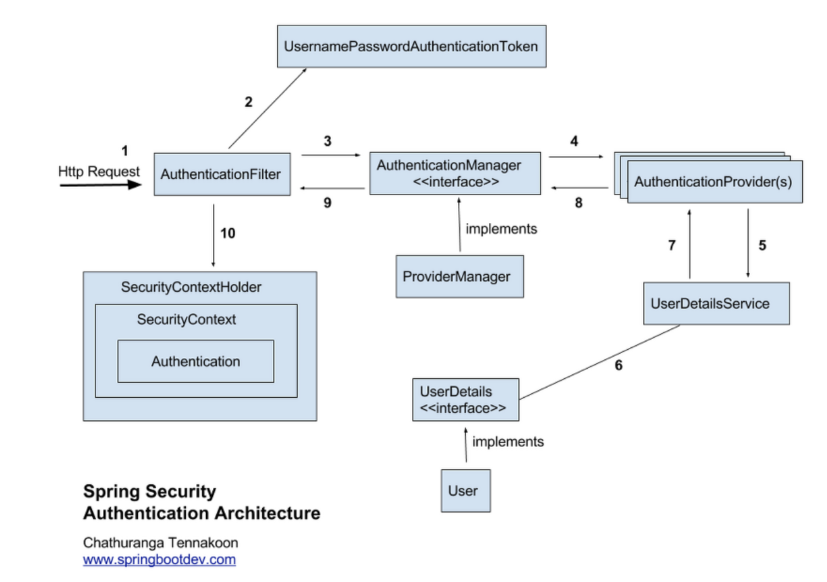Spring Security
0. 들어가면서
Spring Security ??
Spring Security는 강력하고 사용자 정의가 매우 용이한 인증 및 액세스 제어 프레임워크입니다. 이는 Spring 기반 애플리케이션의 보안을 위한 사실상의 표준입니다. Spring Security는 Java 애플리케이션에 인증과 인증을 모두 제공하는 데 중점을 둔 프레임워크입니다.
Authentication / Authorization
- Principal & Credential pattern : username & password
- Authentication 제출 -> 검증 -> Authorization 부여
용어 설명
- Authentication : 사용자가 본인이 맞는지 확인하는 절차
- Authorization : 인증된 사용자가 요청한 자원에 접근 가능한지 결정하는 절차
- Principal : 요청한 자원에 접근하는 대상
- Credential : 자원에 접근하는 대상의 비밀번호
- SecurityContext : Authentication 객체를 보관, 관리, 불러오는 역할
Flowchart

![]()
1. HTTP Request Receive
- Browser(Client)로 부터 request를 받음
- id, password를 기반으로 인증, 권한 부여를 진행
- Application Filter 중에 Authentication Filters에 가장 먼저 도달
2. AuthenticationFilter
- AuthenticationFilter가 인증, 권한 부여를 위한 과정을 먼저 거침
- 위의 과정을 마친 후 Dispatcher Servlet으로 요청을 넘김
3. UsernamePasswordAuthenticationToken
- Authentication Interface의 구현체
- Principal-Credential pattern을 반영한 객체
- 생성자를 통해서 인증 전의 Authentication 객체, 인증 후의 Authentication 객체를 생성
- 모든 접근 주체는 Authentication을 생성하고 SecurityContext에 보관 및 사용
- AbstractAuthenticationToken implements Authentication
- UsernamePasswordAuthenticationToken extends AbstractAuthenticationToken
Authentication Code
public interface Authentication extends Principal, Serializable {
//인증된 사용자의 권한 목록
Collection<? extends GrantedAuthority> getAuthorities();
//사용자 비밀번호
Object getCredentials();
//사용자 상세정보
Object getDetails();
//사용자 아이디
Object getPrincipal();
//사용자 인증 여부
boolean isAuthenticated();
void setAuthenticated(boolean isAuthenticated) throws IllegalArgumentException;
}
UsernamePasswordAuthenticationToken Code
public class UsernamePasswordAuthenticationToken extends AbstractAuthenticationToken {
//사용자 아이디
private final Object principal;
//사용자 비밀번호
private Object credentials;
//인증 완료 전의 객체 생성
public UsernamePasswordAuthenticationToken(Object principal, Object credentials) {
super(null);
this.principal = principal;
this.credentials = credentials;
setAuthenticated(false);
}
//인증 완료 후의 객체 생성
public UsernamePasswordAuthenticationToken(Object principal, Object credentials, Collection<? extends GrantedAuthority> authorities) {
super(authorities);
this.principal = principal;
this.credentials = credentials;
super.setAuthenticated(true);
}
}
AbstractAuthenticationToken Code
public abstract class AbstractAuthenticationToken implements Authentication, CredentialsContainer {
}
4. AuthenticationManager
- authenticate 메소드를 제공하는 interface
- Authentication 객체를 받아 인증하고 성공 시 Authentication 객체를 return
- AuthenticationManager에 등록된 AuthenticationProvider에 의해 인증 처리가 이루어짐
- 인증 성공 시 인증이 성공한 Authentiction 객체를 생성하여 SecurityContext에 저장
- 인증 실패 시 AuthenticationException을 발생시킴
AuthenticationManager Code
public interface AuthenticationManager {
Authentication authenticate(Authentication authentication) throws AuthenticationException;
}
5. ProviderManager(implements AuthenticationManager)
- AuthenticationManger의 구현체
- Spring Security가 관리하는 Bean
- ProviderManager는 여러 AuthenticationProvider를 순회하면서 인증 처리가 가능한 AuthenticationProvider를 찾아서 인증 처리 과정 위임
ProviderManager Code
public class ProviderManager implements AuthenticationManager, MessageSourceAware,InitializingBean {
public List<AuthenticationProvider> getProviders() {
return providers;
}
public Authentication authenticate(Authentication authentication) throws AuthenticationException {
Class<? extends Authentication> toTest = authentication.getClass();
AuthenticationException lastException = null;
Authentication result = nul;
boolean debug = logger.isDebugEnabled();
//AuthenticationProvider 중에 가능한 provider에서 result를 얻어낸다
for (AuthenticationProvider provider : getProviders()) {
try {
result = provider.authenticate(authentication);
if (result != null) {
copyDetails(authentication, result);
break;
}
}
catch (AccountStatusException e) {
prepareException(e, authentication);
throw e;
}
....
}
throw lastException;
}
}
SecurityConfig에서 직접 customize한 provider를 등록할 수 있음(빈 등록 후 ProviderManager에 AuthenticationProvider로 등록)
@Configuration
@EnableWebSecurity
public class SecurityConfig extends WebSecurityConfigurerAdapter {
@Bean
public AuthenticationManager getAuthenticationManager() throws Exception {
return super.authenticationManagerBean();
}
@Bean
public customizeAuthenticationProvider customizeAuthenticationProvider() throws Exception {
return new customizeAuthenticationProvider();
}
@Override
protected void configure(AuthenticationManagerBuilder auth) throws Exception {
auth.authenticationProvider(customizeAuthenticationProvider());
}
}
6. AuthenticationProvider
- AuthenticationProviders 중에 실제 검증을 수행하는 AuthenticationProvider
- principal을 바탕으로 해당 유저의 정보를 조회
- UserDetailService 구현체를 사용하여 유저의 정보가 담겨있는 객체를 반환
- 인증 성공 시 인증하기 전의 Authentication 객체를 받아서 인증이 완료된 Authentication 객체로 반환
- 인증 실패 시 AuthenticationException 발생
AuthenticationProvider Code
public interface AuthenticationProvider {
//인증 전의 Authenticaion 객체를 인증된 Authentication 객체로 반환
Authentication authenticate(Authentication var1) throws AuthenticationException;
boolean supports(Class<?> var1);
}
7. UserDetailsService
- DB에서 유저 정보를 불러와서 유저의 정보가 담겨있는 객체를 만듬
UserDetailService Code
public interface UserDetailsService {
UserDetails fetchUserDetailByUserId(String userId) throws UsernameNotFoundException;
}
UserDetail Code
public interface UserDetails extends Serializable {
Collection<? extends GrantedAuthority> getAuthorities();
String getPassword();
String getUsername();
boolean isAccountNonExpired();
boolean isAccountNonLocked();
boolean isCredentialsNonExpired();
boolean isEnabled();
}
